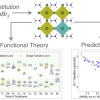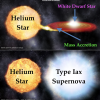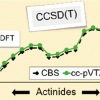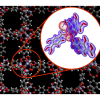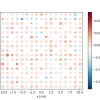Science Vignettes
Machine-Learned Impurity Prediction in Semiconductors
Argonne National Laboratory researchers ran high-throughput simulations on NERSC supercomputers and generated comprehensive datasets of impurity properties in two classes of semiconductors: lead-based hybrid perovskites and cadmium-based chalcogenides. These datasets led to machine learned models that enable accelerated prediction and design for the entire chemical space of materials and impurities in these semiconductor classes. Read More »
Detection of Helium in Sub-luminous Thermonuclear Supernovae
Connecting Explosion Composition Models with Progenitor Channels Science Achievement Researchers at the University of California Santa Cruz have used the elemental composition of a peculiar supernova explosion to understand its complex origins. Using the NERSC supercomputers at Lawrence Berkeley Laboratories, the UCSC team modeled the material ejected in a new class of thermonuclear explosion called a Type Iax supernova (SN Iax). This recently discovered class of stellar explosion is… Read More »
Binding Preferences Predictions Across the Actinide Series
Researchers from the Institute for Nuclear Security and Radiochemistry Center of Excellence at the University of Tennessee, University of North Texas, U.S. Army Nuclear and Countering Weapons of Mass Destruction Agency, Stony Brook University, Brookhaven National Laboratory, and Y-12 National Security Complex evaluated method dependence in binding preferences across the actinide series. NERSC supercomputers allowed for accurate targets to be established – essential to evaluate less expensive methods to be applied in binding of elements of interest in nuclear security and fundamental research of lesser-known actinide compounds. Read More »
New Methodology for Simulating Nanoporous Materials
Researchers at the Nanoporous Materials Genome Center (NMGC) at the University of Minnesota have developed new molecular simulation methodology that allows for the highly accurate computation of material properties for a fraction of the computational cost. This new methodology can calculate the adsorption energies of small molecules in nanoporous materials such as zeolites and metal-organic frameworks (MOFs). Thanks to large benchmarking simulations run on NERSC supercomputers, the team was able to validate the new methodology for hydrogen adsorption. Read More »
Quantifying Systematic Error in Monte Carlo Simulations
Scientific Achievement Quantifying the potential bias in Monte Carlo eigenvalue simulations due to undersampling (too few particles per fission generation) has been difficult historically because of the computational resources required to obtain reference solutions. Using an ALCC grant on the Cori supercomputer, we obtained finely discretized flux solutions to a small modular reactor (SMR) problem with extremely small statistical error that has allowed us to definitely quantify undersampling… Read More »






